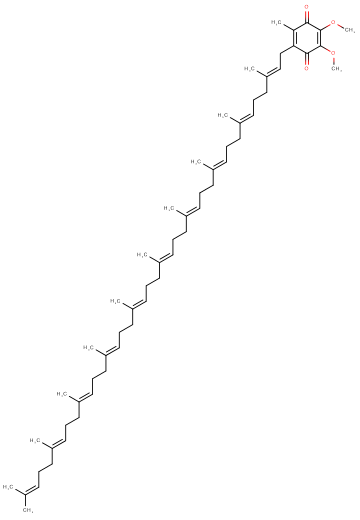
Coenzyme Q10
CAS No. 303-98-0
Coenzyme Q10( CoQ10 )
Catalog No. M13959 CAS No. 303-98-0
Extracted from Coenzyme Q10;Suitability:Chloroform,benzene and carbon tetrachloride.
Purity : >98% (HPLC)
 COA
COA
 Datasheet
Datasheet
 HNMR
HNMR
 HPLC
HPLC
 MSDS
MSDS
 Handing Instructions
Handing Instructions
| Size | Price / USD | Stock | Quantity |
| 200MG | 38 | In Stock |


|
| 500MG | 82 | In Stock |


|
| 1G | 122 | In Stock |


|
Biological Information
-
Product NameCoenzyme Q10
-
NoteResearch use only, not for human use.
-
Brief DescriptionExtracted from Coenzyme Q10;Suitability:Chloroform,benzene and carbon tetrachloride.
-
DescriptionExtracted from Coenzyme Q10;Suitability:Chloroform,benzene and carbon tetrachloride;Store the product in sealed,cool and dry condition.(In Vitro):Coenzyme Q10 is an obligatory member of the respiratory chain in the mitochondria of all cells. Therefore, it is an essential ingredient in the formation of adenosine triphosphate (ATP), the source of energy in most cellular processes. Coenzyme Q10 is located in the mitochondria, lysosomes, and Golgi and plasma membranes, and provides an antioxidant action either by direct reaction with free radicals or by regeneration of tocopherol and ascorbate from their oxidised state. Coenzyme Q10 is a popular dietary supplement because of its recognition by the public as an important nutrient in supporting human health. The rationale for the use of Coenzyme Q10 as a therapeutic agent in several cardiovascular and degenerative neurologic and neuromuscular diseases is based upon its fundamental role in mitochondrial function and cellular bioenergetics. (In Vivo):Because of its hydrophobicity and large molecular weight, absorption of dietary Coenzyme Q10 is slow and limited. In the case of dietary supplements, solubilized Coenzyme Q10 formulations show enhanced bioavailability. The Tmax is around 6 h, with an elimination half-life of about 33 h. The reference intervals for plasma Coenzyme Q10 range from 0.40 to 1.91 mM in healthy subjects. With Coenzyme Q10 supplements there is reasonable correlation between increase in plasma Coenzyme Q10 and ingested dose up to a certain point. Animal data show that Coenzyme Q10 in large doses is taken up by all tissues including heart and brain mitochondria. In 12-month-old rats administration of coenzyme Q10 results in significant increases in cerebral cortex mitochondrial concentrations of coenzyme Q10. Oral administration of coenzyme Q10 markedly attenuates striatal lesions produced by systemic administration of 3-nitropropionic acid and significantly increases life span in a transgenic mouse model of familial amyotrophic lateral sclerosis.
-
In VitroCoenzyme Q10 is an obligatory member of the respiratory chain in the mitochondria of all cells. Therefore, it is an essential ingredient in the formation of adenosine triphosphate (ATP), the source of energy in most cellular processes. Coenzyme Q10 is located in the mitochondria, lysosomes, and Golgi and plasma membranes, and provides an antioxidant action either by direct reaction with free radicals or by regeneration of tocopherol and ascorbate from their oxidised state. Coenzyme Q10 is a popular dietary supplement because of its recognition by the public as an important nutrient in supporting human health. The rationale for the use of Coenzyme Q10 as a therapeutic agent in several cardiovascular and degenerative neurologic and neuromuscular diseases is based upon its fundamental role in mitochondrial function and cellular bioenergetics.
-
In VivoBecause of its hydrophobicity and large molecular weight, absorption of dietary Coenzyme Q10 is slow and limited. In the case of dietary supplements, solubilized Coenzyme Q10 formulations show enhanced bioavailability. The Tmax is around 6 h, with an elimination half-life of about 33 h. The reference intervals for plasma Coenzyme Q10 range from 0.40 to 1.91 mM in healthy subjects. With Coenzyme Q10 supplements there is reasonable correlation between increase in plasma Coenzyme Q10 and ingested dose up to a certain point. Animal data show that Coenzyme Q10 in large doses is taken up by all tissues including heart and brain mitochondria. In 12-month-old rats administration of coenzyme Q10 results in significant increases in cerebral cortex mitochondrial concentrations of coenzyme Q10. Oral administration of coenzyme Q10 markedly attenuates striatal lesions produced by systemic administration of 3-nitropropionic acid and significantly increases life span in a transgenic mouse model of familial amyotrophic lateral sclerosis.
-
SynonymsCoQ10
-
PathwayOthers
-
TargetOther Targets
-
RecptorOthers
-
Research AreaOther Indications
-
Indication——
Chemical Information
-
CAS Number303-98-0
-
Formula Weight863.37
-
Molecular FormulaC59H90O4
-
Purity>98% (HPLC)
-
SolubilityEthanol: <1 mg/mL (<1 mM); Water: <1 mg/mL (<1 mM); DMSO: <1 mg/mL (<1 mM)
-
SMILESO=C(C(OC)=C1OC)C(C)=C(C/C=C(C)/CC/C=C(C)/CC/C=C(C)/CC/C=C(C)/CC/C=C(C)/CC/C=C(C)/CC/C=C(C)/CC/C=C(C)/CC/C=C(C)/CC/C=C(C)\C)C1=O
-
Chemical Name2-((2E,6E,10E,14E,18E,22E,26E,30E,34E)-3,7,11,15,19,23,27,31,35,39-decamethyltetraconta-2,6,10,14,18,22,26,30,34,38-decaen-1-yl)-5,6-dimethoxy-3-methylcyclohexa-2,5-diene-1,4-dione
Shipping & Storage Information
-
Storage(-20℃)
-
ShippingWith Ice Pack
-
Stability≥ 2 years
Reference
1.Crane FL, J Am Coll Nutr, 2001, 20(6), 591-598.
molnova catalog



related products
-
Braco-19 trihydrochl...
BRACO19 is a telomerase inhibitor. It also stabilizes G-quadruplexes, targeting telomeric G-quadruplexes.
-
[pSer2, pSer5, pSer7...
[pSer2, pSer5, pSer7]-CTD is a substrate for CDK7(cyclin-dependent protein kinase), a phosphorylated polypeptide at ser2, ser5, and ser7 of RNA polymerase II carboxyl terminus (CTD).
-
Dexamethasone Phosph...
Dexamethasone disodium phosphate is a water-soluble form of the synthetic glucocorticoid dexamethasone.



 Cart
Cart
 sales@molnova.com
sales@molnova.com


